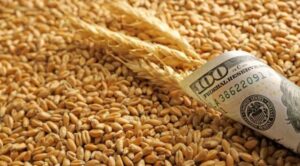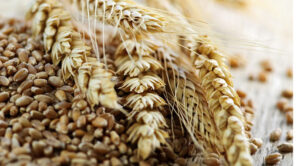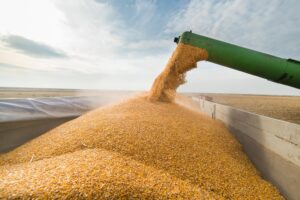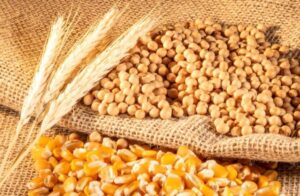
Since the beginning of the 2024-2025 marketing year and as of December 9, Ukraine has exported 18.981 mln tonnes of grains and pulses, of which 606 tonnes were shipped this month, the press service of the Ministry of Agrarian Policy and Food reported, citing data from the State Customs Service of Ukraine.
According to the report, as of December 13 last year, the total shipments amounted to 14.697 mln tonnes, including 1.6 mln tonnes in December.
In terms of crops, since the beginning of the current season, Ukraine has exported 9.115 million tons of wheat (121 thousand tons in December), 1.866 million tons of barley (4 thousand tons), 10.8 thousand tons of rye (0), and 7.684 million tons of corn (475 thousand tons).
The total export of Ukrainian flour since the beginning of the season as of December 9 is estimated at 33.3 thsd tonnes (1.6 thsd tonnes in December), including 30.5 thsd tonnes of wheat (1.5 thsd tonnes).

Electricity exports to Europe in November decreased by 31% compared to October and were almost four times lower than imports, according to DiXi Group, a Ukrainian think tank in the areas of politics, energy and security, citing Energy Map.
“Last month, electricity exports fell by 31% to 41.9 thousand MWh,” DiXi Group said in a Facebook post.
According to it, 30% or 12.7 thousand MWh went to Slovakia, another 23% (9.4 thousand MWh) to Hungary. 19% (8.1 thousand MWh and 7.8 thousand MWh) went to Moldova and Romania. 9% (3.9 thousand MWh) went to Poland.
According to DiXi’s information, imports amounted to 162.4 thousand MWh, which is 11% less than in October and almost four times more than exports.
DiXi explained that exports fell in the second half of last month, while imports increased due to Russia’s massive attacks on energy infrastructure on November 17 and 28, which led to a shortage in the power system.
As reported, according to D.Trading, in November-2024, Ukraine remained a net importer of electricity, and its imports amounted to 165 million kWh, which is 9% lower than in October.
As DiXi reported earlier, in October-2024, Ukraine exported 60.7 thousand MWh instead of 0.7 thousand MWh in September.
Despite the overall shortage of electricity caused by 11 massive Russian attacks on the power system this year, at certain hours, in particular, during the active operation of renewable energy generation, as well as at night, Ukraine has a surplus, which allows for exports. An alternative to exports is, in particular, a forced limitation of electricity production from renewable energy sources, which should be compensated by NPC Ukrenergo. Due to the surplus, other types of generation should also reduce their capacity.

Ukraine exported 8.96 mln tonnes of wheat in July-November of 2024/25 marketing year (MY July-2024 – June 2025), which is significantly higher than last year’s pace, when 5.8 mln tonnes were exported in the same five months of the season, but it is lower than the pre-war dynamics, UkrAgroConsult news agency reported.
“Nevertheless, in the first five months of the season-2024/25, 55% of the maximum wheat exports approved in August under the memorandum between the Ministry of Agrarian Policy and Food and specialized organizations of the Ukrainian grain market have already been realized,” the analysts said.
According to them, the top five importers of Ukrainian wheat are three countries of Southeast Asia: Indonesia, Vietnam and Thailand.
It is noted that the share of remote markets has increased significantly due to the stable operation of the sea corridor, but Spain remains the main destination. Among the interesting destinations is Algeria, which has already imported more than half a million tons of Ukrainian wheat this season. At the same time, the poor harvest in France prompted local importers to switch to Black Sea grain, UkrAgroConsult explains the trends.

As of December 6, Ukraine exported 18.855 mln tonnes of grains and pulses since the beginning of 2024-2025 marketing year, 480 thsd tonnes of which were shipped since the beginning of the month, the press service of the Ministry of Agrarian Policy and Food reported, citing the data of the State Customs Service.
According to the report, as of the same date last year, the total shipments amounted to 13.723 mln tons, including 626 thsd tonnes in December.
At the same time, in 2024-2025 marketing year, the exports of all major crops are significantly higher than last year. Thus, since the beginning of the current season, Ukraine has exported 9.078 mln tonnes of wheat (6.057 mln tonnes in 2023/24 MY), 1.865 mln tonnes of barley (889 thsd tonnes), 10.8 thsd tonnes of rye (0.9 thsd tonnes), and 7.6 mln tonnes of corn (6.642 mln tonnes).
The total export of Ukrainian flour since the beginning of the season as of December 6 is estimated at 32.8 thsd tonnes (in 2023/24 MY – 51.1 thsd tonnes), including 30 thsd tonnes of wheat (48.8 thsd tonnes).

Biosphere Corporation, one of the market leaders in the production and distribution of household goods, plans to open a production facility in Uzbekistan next year to produce recycled garbage bags rather than virgin polymers and actively promote its products in this and neighboring Central Asian markets, according to Andriy Zdesenko, the corporation’s founder and CEO.
“This will load our Polygreen plant in Fastiv, which currently has a 20% capacity reserve. And it will allow us to build another plant in Ukraine that will produce pellets and send them to Uzbekistan to produce garbage bags, which we will then supply to neighboring countries,” he said in an interview with Interfax-Ukraine.
“And then sponge sponges, foil-film, slider bags – the whole range that is necessary for development,” Zdesenko added.
He clarified that Uzbekistan has protected its market by banning the export of garbage bags of a certain thickness and thus stimulated the launch of domestic production. In addition, the cost of logistics to the region, for example, to Kazakhstan, has tripled due to the war, and delivery times have increased from three weeks to two months.
“Therefore, if we want to be in the market of Uzbekistan, where I think there will be 40 million people in five years, we need to produce there,” said the Biosphere CEO.
He also emphasized that there are about 100 million people around Uzbekistan, including Afghanistan, whose market is actively developing, and there are many trade hubs in the region where business is very active.
Biosphere Corporation has been operating in Ukraine for over 25 years. The product portfolio includes more than 1 thousand items under 16 own brands (Freken BOK, Faynyi Bonus, Vortex, Likit, Smile, Smile Baby, Superfresh, Bambik, Novita, Lady Cotton, Alufix, PRO service, GoWipes, Chysta Peremoha, Pany Blisk and PoketMon). The corporation is the official distributor of such international brands as TORK, Selpak and Fantom.
The corporation’s capacities in Ukraine are represented by three plants with a total production area of 35 thousand square meters in Dnipropetrovska, Kyivska and Khmelnytska regions, as well as logistics complexes with an area of 30 thousand square meters. Together with the French Groupe Lemoine, Biosphere also owns a plant in Estonia for the production of cotton products with an area of 8.5 thousand square meters.
At the end of 2023, the company opened a new FOOD business line with its own Cupsoul production, represented by such tea brands as Graff, Ritz Barton, and others.

In November 2024, Ukraine exported 6.2 million tons of agricultural products, which is 6.5% less than the same indicator of the previous month, but it is still a good monthly export figure, according to the Ukrainian Agribusiness Club (UCAB).
According to the report, in November 2024, Ukraine increased grain exports by 3%, of which corn accounted for 63%, wheat – 33%, and barley – 4%.
Supplies of oilseeds to foreign markets decreased by 32% to 0.8 mln tons (soybeans – 58% and rapeseed – 41%), vegetable oils – by 8% to 541.2 thsd tonnes. tons (sunflower oil – 89%, soybean oil – 9% and rapeseed oil – 2%), cake after extraction of vegetable oils – by 19% to 383.3 thousand tons (sunflower oil – 78%, soybean oil – 12%), other types of agricultural products – by 5% to 398.5 thousand tons.
“The growth is observed only in the grain group, while the rest of the categories show a decline. The biggest decline was in oilseeds, which decreased by one third. The main reason is the slowdown in rapeseed exports, as the lion’s share of it has already been exported,” commented UCAB.